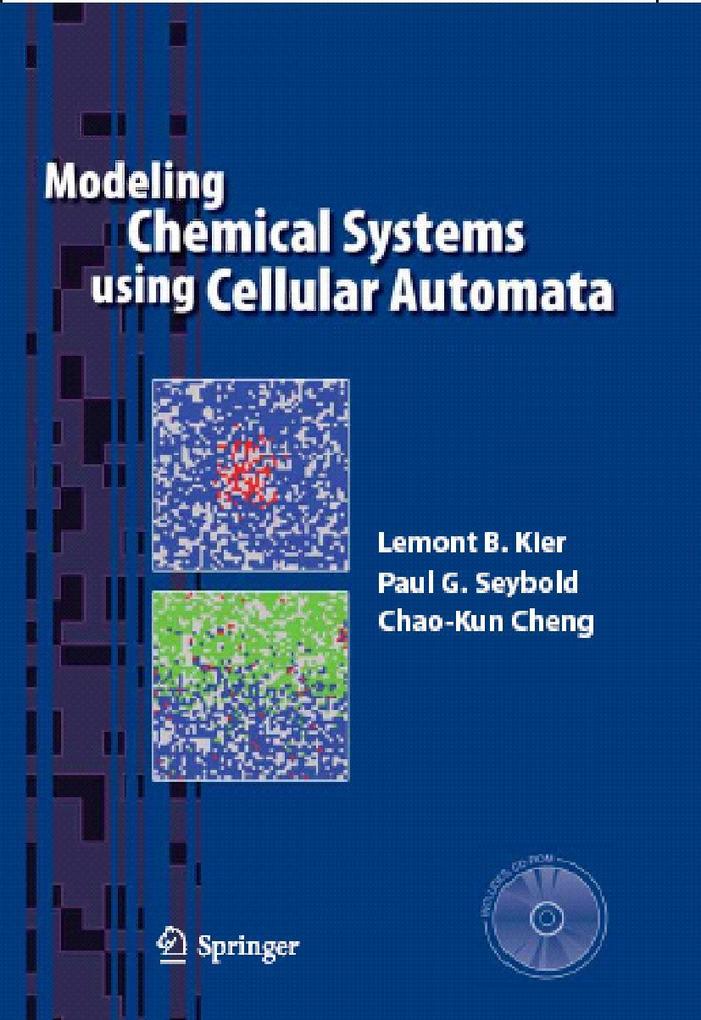
ISBN: 9781402036576
Modeling Chemical Systems using Cellular Automata provides a practical introduction to an exciting modeling paradigm for complex systems. The book first discusses the nature of scientific… Altro …
| Indigo.ca new in stock. Costi di spedizione:zzgl. Versandkosten., Costi di spedizione aggiuntivi Details... |

2005, ISBN: 1402036574
With CD-ROM Gebundene Ausgabe Science, COMPUTERS / Computer Science, COMPUTERS / Computer Simulation, SCIENCE / Chemistry / Physical & Theoretical, Physikalische Chemie, mit Schutzumsch… Altro …
| Achtung-Buecher.de MARZIES.de Buch- und Medienhandel, 14621 Schönwalde-Glien Costi di spedizione:Versandkostenfrei innerhalb der BRD. (EUR 0.00) Details... |

ISBN: 1402036574
Modeling Chemical Systems Using Cellular Automata ab 47.52 € als gebundene Ausgabe: A Textbook and Laboratory Manual. With CD-ROM. Aus dem Bereich: Bücher, Wissenschaft, Chemie, Medien > … Altro …
| Hugendubel.de Nr. 5298989. Costi di spedizione:, , DE. (EUR 0.00) Details... |

ISBN: 9781402036576
Modeling Chemical Systems Using Cellular Automata - A Textbook and Laboratory Manual. With CD-ROM: ab 56.59 € Bücher > Wissenschaft > Chemie SPRINGER NATURE, SPRINGER NATURE
| eBook.de Costi di spedizione:in stock, , , DE. (EUR 0.00) Details... |

ISBN: 9781402036576
Modeling Chemical Systems Using Cellular Automata - A Textbook and Laboratory Manual. With CD-ROM: ab 54.79 € Bücher > Wissenschaft > Chemie SPRINGER NATURE, SPRINGER NATURE
| eBook.de Costi di spedizione:in stock, , , DE. (EUR 0.00) Details... |

Modeling Chemical Systems Using Cellular Automata by Lemont B. Kier Hardcover | Indigo Chapters - nuovo libro
ISBN: 9781402036576
Modeling Chemical Systems using Cellular Automata provides a practical introduction to an exciting modeling paradigm for complex systems. The book first discusses the nature of scientific… Altro …
Kier, Lemont B.; Seybold, Paul G.; Cheng, Chao-Kun:
Modeling Chemical Systems Using Cellular Automata - copertina rigida, flessible2005, ISBN: 1402036574
With CD-ROM Gebundene Ausgabe Science, COMPUTERS / Computer Science, COMPUTERS / Computer Simulation, SCIENCE / Chemistry / Physical & Theoretical, Physikalische Chemie, mit Schutzumsch… Altro …

ISBN: 1402036574
Modeling Chemical Systems Using Cellular Automata ab 47.52 € als gebundene Ausgabe: A Textbook and Laboratory Manual. With CD-ROM. Aus dem Bereich: Bücher, Wissenschaft, Chemie, Medien > … Altro …

ISBN: 9781402036576
Modeling Chemical Systems Using Cellular Automata - A Textbook and Laboratory Manual. With CD-ROM: ab 56.59 € Bücher > Wissenschaft > Chemie SPRINGER NATURE, SPRINGER NATURE

ISBN: 9781402036576
Modeling Chemical Systems Using Cellular Automata - A Textbook and Laboratory Manual. With CD-ROM: ab 54.79 € Bücher > Wissenschaft > Chemie SPRINGER NATURE, SPRINGER NATURE
Dati bibliografici del miglior libro corrispondente
| Autore: | |
| Titolo: | |
| ISBN: |
Informazioni dettagliate del libro - Modeling Chemical Systems Using Cellular Automata by Lemont B. Kier Hardcover | Indigo Chapters
EAN (ISBN-13): 9781402036576
ISBN (ISBN-10): 1402036574
Copertina rigida
Copertina flessibile
Anno di pubblicazione: 2005
Editore: Lemont B. Kier
175 Pagine
Peso: 0,495 kg
Lingua: eng/Englisch
Libro nella banca dati dal 2007-03-09T10:28:52+01:00 (Zurich)
Pagina di dettaglio ultima modifica in 2022-10-19T17:59:02+02:00 (Zurich)
ISBN/EAN: 9781402036576
ISBN - Stili di scrittura alternativi:
1-4020-3657-4, 978-1-4020-3657-6
Stili di scrittura alternativi e concetti di ricerca simili:
Autore del libro : kun, seybold, chao, automata, lem, kier, choluj, cheng eng, paul chen
Titolo del libro: cell, cellular automata, textbook, laboratory, files
Dati dell'editore
Autore: Lemont B. Kier; Paul G. Seybold; Chao-Kun Cheng
Titolo: Modeling Chemical Systems using Cellular Automata
Editore: Springer; Springer Netherland
175 Pagine
Anno di pubblicazione: 2005-10-10
Dordrecht; NL
Lingua: Inglese
106,99 € (DE)
109,99 € (AT)
118,00 CHF (CH)
Available
VIII, 175 p. With online files/update.
BB; Hardcover, Softcover / Chemie/Theoretische Chemie; Chemoinformatik; Verstehen; cellular automata; complex systems; dynamic systems; modeling; simulation; simulations; systems modelling; Computational Chemistry; Mathematical Applications in Chemistry; Physical Chemistry; Theoretical Chemistry; Computer Modelling; Quanten- und theoretische Chemie; Physikalische Chemie; Computermodellierung und -simulation; BC
The book will be of great value in undergraduate courses in chemistry, physics, biology, applied mathematics, and bioinformatics, and as a supplement for laboratory courses in introductory chemistry, organic chemistry, physical chemistry, medicinal chemistry, chemical engineering and other courses dealing with statistical and dynamic systems. It allows the exploration of a wide range of dynamic phenomena, many of which are not normally accessible within conventional laboratory settings due to limitations of time, cost, and experimental equipment.
Thebook is both a textbook on applied Cellular Automata and a lab manual for chemistry (physics, engineering) courses with lab activity. It would supplement other lab work and be an additonal book the students would use in the course.
The authors have assessed the emerging need for this kind of activity in science labs because of the cost of the practical activitites and the frequent failure of some exercises leading to lost didactic value of some experiments. This book is pioneering an alternative that will grow in use.
There are no course directors who would use Cellular Automata exclusively. The authors see an emerging interest in this kind of work in courses that contain lab exercises. One such course is the graduate course that Lemont Kier gives in Life Sciences about complexity. He uses many examples and studies from Cellular Automata in the latter part of this course.
Modeling Chemical Systems using Cellular AutomataPreface.- Modeling Nature: The System. States of the System. Models in Chemistry.- Cellular Automata: What are Cellular Automata. The Grid and the Cells. The Rules. Running a Simulation. The Output. Putting it all Together. Applications.- Water as a System: Experimental Design. The Movement Rules. The Attributes Recorded. Other Liquids. Applications.- Solution Systems: The Rules. Applications.- Dynamic Aqueous Systems: Oil-Water Demixing. Micelle Formation. Crystal Formation. Percolation.- Water Surface Effects: Water-Surface Encounters. Chromatography. Membrane Permeability.- First Order Chemical Kinetics: Exponential Decay. First Order Equilibrium. Series Reactions. Parallel Reactions. Kinetic and Thermodynamic Reaction Control.- Second Order Chemical Kinetics: Second Order Models.- Additional Applications in Chemical Kinetics: Enzyme Kinetics. Liquid-Vapor Equilibrium.- Use of the CASim Program: The System and Program. Organization of the CA Program. Setting up a Simulation.- Index.- CD-ROM included.
(Undergraduate Projects in Application of Artificial Intellegence. III. Cellular Automata. Cartwright & Yiasoumis. Chemical Educator 2001, 6)There are no course directors who would use Cellular Automata exclusively. The authors see an emerging interest in this kind of work in courses that contain lab exercises. One such course is the graduate course that Lemont Kier gives in Life Sciences about complexity. He uses many examples and studies from Cellular Automata in the latter part of this course.
There are few publications on Cellular Automata and certainly no direct competition Insight into a new modeling paradigm Novel approach to the use of in silico modeling to replace or supplement costly labs
Altri libri che potrebbero essere simili a questo:
Ultimo libro simile:
9789400796348 Modeling Chemical Systems using Cellular Automata (Kier, Lemont B.; Cheng, Chao-Kun; Seybold, Paul G.)
- 9789400796348 Modeling Chemical Systems using Cellular Automata (Kier, Lemont B.; Cheng, Chao-Kun; Seybold, Paul G.)
- 9789048104123 Modeling Chemical Systems Using Cellular Automata (Kier, Lemont B.; Seybold, Paul G.; Cheng, Chao-Kun)
- 9781402036903 Modeling Chemical Systems using Cellular Automata (Chao-Kun Cheng; Lemont B. Kier; Paul G. Seybold)
- Modeling Chemical Systems using Cellular Automata (Chao-Kun Cheng, Lemont B. Kier, Paul G. Seybold)
< Per archiviare...



